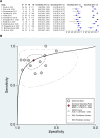Airway Ultrasound as Predictor of Difficult Direct Laryngoscopy: A Systematic Review and Meta-analysis
- PMID: 34914641
- PMCID: PMC8903216
- DOI: 10.1213/ANE.0000000000005839
Airway Ultrasound as Predictor of Difficult Direct Laryngoscopy: A Systematic Review and Meta-analysis
Abstract
Background: Despite several clinical index tests that are currently applied for airway assessment, unpredicted difficult laryngoscopy may still represent a serious problem in anesthesia practice. The aim of this systematic review and meta-analysis was to evaluate whether preoperative airway ultrasound can predict difficult direct laryngoscopy in adult patients undergoing elective surgery under general anesthesia.
Methods: We searched the Medline, Scopus, and Web of Science databases from their inception to December 2020. The population of interest included adults who required tracheal intubation for elective surgery under general anesthesia without clear anatomical abnormalities suggesting difficult laryngoscopy. A bivariate model has been used to assess the accuracy of each ultrasound index test to predict difficult direct laryngoscopy.
Results: Fifteen studies have been considered for quantitative analysis of summary receiver operating characteristic (SROC). The sensitivity for distance from skin to epiglottis (DSE), distance from skin to hyoid bone (DSHB), and distance from skin to vocal cords (DSVC) was 0.82 (0.74-0.87), 0.71 (0.58-0.82), and 0.75 (0.62-0.84), respectively. The specificity for DSE, DSHB, and DSVC was 0.79 (0.70-0.87), 0.71 (0.57-0.82), and 0.72 (0.45-0.89), respectively. The area under the curve (AUC) for DSE, DSHB, DSVC, and ratio between the depth of the pre-epiglottic space and the distance from the epiglottis to the vocal cords (Pre-E/E-VC) was 0.87 (0.84-0.90), 0.77 (0.73-0.81), 0.78 (0.74-0.81), and 0.71 (0.67-0.75), respectively. Patients with difficult direct laryngoscopy have higher DSE, DSVC, and DSHB values than patients with easy laryngoscopy, with a mean difference of 0.38 cm (95% confidence interval [CI], 0.17-0.58 cm; P = .0004), 0.18 cm (95% CI, 0.01-0.35 cm; P = .04), and 0.23 cm (95% CI, 0.08-0.39 cm; P = .004), respectively.
Conclusions: Our study demonstrates that airway ultrasound index tests are significantly different between patients with easy versus difficult direct laryngoscopy, and the DSE is the most studied index test in literature to predict difficult direct laryngoscopy. However, it is not currently possible to reach a definitive conclusion. Further studies are needed with better standardization of ultrasound assessment to limit all possible sources of heterogeneity.
Copyright © 2021 The Author(s). Published by Wolters Kluwer Health, Inc. on behalf of the International Anesthesia Research Society.
Conflict of interest statement
Conflicts of Interest: See Disclosures at the end of the article.
Figures



References
-
- Vannucci A, Cavallone LF. Bedside predictors of difficult intubation: a systematic review. Minerva Anestesiol. 2016;82:69–83. - PubMed
-
- Khan ZH, Kashfi A, Ebrahimkhani E. A comparison of the upper lip bite test (a simple new technique) with modified Mallampati classification in predicting difficulty in endotracheal intubation: a prospective blinded study. Anesth Analg. 2003;96:595–599. - PubMed
-
- Nørskov AK, Rosenstock CV, Wetterslev J, Astrup G, Afshari A, Lundstrøm LH. Diagnostic accuracy of anaesthesiologists’ prediction of difficult airway management in daily clinical practice: a cohort study of 188 064 patients registered in the Danish Anaesthesia Database. Anaesthesia. 2015;70:272–281. - PubMed
-
- Cattano D, Panicucci E, Paolicchi A, Forfori F, Giunta F, Hagberg C. Risk factors assessment of the difficult airway: an Italian survey of 1956 patients. Anesth Analg. 2004;99:1774–1779. - PubMed
-
- Levitan RM, Everett WW, Ochroch EA. Limitations of difficult airway prediction in patients intubated in the emergency department. Ann Emerg Med. 2004;44:307–313. - PubMed
Publication types
MeSH terms
LinkOut - more resources
Full Text Sources
Medical

